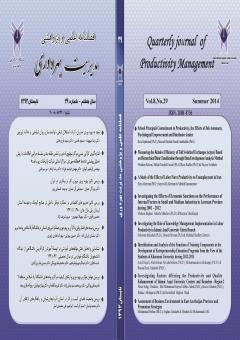بررسی تاثیر بهرهوری نیرویکار بر بیکاری در ایران
الموضوعات : Business Managementرویا آلعمران 1 , سید علی آل عمران 2 , وحیده کسمایی پور 3
1 - استادیار، دانشگاه آزاد اسلامی، واحد تبریز، گروه اقتصاد، تبریز، ایران
2 - دانشجوی دکتری اقتصاد شهری و منطقه ای، دانشگاه تبریز، تبریز، ایران
3 - کارشناس ارشد، دانشگاه آزاد اسلامی، واحد تبریز، گروه اقتصاد، تبریز، ایران
الکلمات المفتاحية: بیکاری, بهرهوری نیرویکار, روش حداقل مربعات معمولی,
ملخص المقالة :
بیکاری یکی از موانع جدی برای پیشرفت های اقتصادی و اجتماعی محسوب می شود. بنابراین برای جلوگیری از اثار منفی بیکاری، کاهش نرخ بیکاری را به عنوان یکی از اهداف برجسته توسعه در کشورهای در حال توسعه باید در نظر گرفت. یکی از مشخصه های کشورهای در حال توسعه، پایین بودن نرخ رشد بهره وری است و افزایش بهره وری در نتیجه ی کاهش استفاده از منابع، کاهش هزینه و استفاده از روش های بهتر تولید یا بهبود توانایی عوامل تولید، مخصوصا نیروی کار حاصل می شود. بر این اساس هدف پژوهش حاضر، بررسی تاثیر بهره وری نیروی کار بر بیکاری در ایران در فاصله ی سال های 1357 تا 1389 است. برای تحلیل موضوع؛ از روش اقتصادسنجی حداقل مربعات معمولی استفاده شده است. داده های به کار برده شده در پژوهش حاضر، از نوع داده های سری زمانی سالانه می باشد. بر اساس نتایج به دست آمده از این روش، اثرگذاری ضرایب تمامی متغیرها بر اساس مبانی نظری مورد انتظار بوده و از نظر آماری نیز معنی دار می باشد و بهره وری نیروی کار اثری منفی بر میزان بیکاری دارد.
Beheshti, M. B., Khayavar, M. H., & Qazvinian, M. H. (2009). Study of the Relation Between Entrepreneurship and Unemployment in Iran's Industrial Sector. Beyond Management, 183-157, (In Persian).
Chiarini, Bruno and Piselli (2005), Business Cycle, Unemployment Benefits and Productivity Shocks, Journal of Macroeconomics, Vol.27, PP: 670-690.
Fallahi, M. A., Hosseinzadeh Bahreini, M. H., & Moghaddamnejad, H. (2012). The Relationship between Productivity and Employment Changes in Iran's Industry (Application of the Blenchard-Cove Analysis Method). Journal of Research on Growth and Economic Development, 8, pp. 23-36, (In Persian).
Gallegati, Marco and Gallegati, Mauro and Ramsey, James B. and Semmler, Willi (2011), Productivity and Unemployment Scale-by-Scale Relationship, available at: www.google.com
Jalaei, S. A., & Shirafakan, M. (2009). The Effect of Monetary Policies on the Execution Level by Analyzing the Phillips New-Keynesian Curve in Iran. Economic Sciences Journal, 2, 13-36, (In Persian).
Minqi, Li (2004), Aggregate Demand, Productivity and Disguised Unemployment in the Chinese Industrial Sector, World Development, Vol. 32, No.3, PP: 409-425.
Mosaee, M., & Garshasbi-Fakhr, S. (2010). The Study of the Relationship between Unemployment and Trafficking in Narcotic Drugs in Iran. Social Issues, 7, pp. 145-167, (In Persian).
Najar Nahavandi, M., & Khaki, A. (2009). Demographic Analysis of Unemployment in Active Population in Different Provinces of the Country Based on the 2006 Census. Journal of Iranian Demography Institute, 7, 115-139, (In Persian).
Okudaira, Hiroko and Takizawa, Miho and Tsuru, Kotaro (2011), Employlent Protection and Productivity: Evidence from Firm-Level Panel Data in Japan, RIETI Discussion Paper Series 11-E-078.
Qavidel, S. (2008). Self-Employment in Unemployment (Case of Iran). Journal of Economic Research, 1, 21-41, (In Persian).
Razini, E. A., Suri, A. R., & Hosseini, A. (2011). Unemployment and Government Measure: Is There An Existing Relationship?. Quarterly Journal of Economic Research, 2, 35-57, (In Persian).
Samty, M., & Albusovillem, M. (2009). The Impact of Participation Rate and Unemployment Rate on the Underground Economies in OECD Countries. Quantitative Economics Quarterly, 2, 63-88, (In Persian).
Shahabadi, A., & Khani, Z. (2012). Investigating the Relation Between the Efficiency of Total Factors and the Unemployment Rate in Iran's Economy. Journal of Economic Growth and Development Researches, 17, 35-58, (In Persian).
_||_
Beheshti, M. B., Khayavar, M. H., & Qazvinian, M. H. (2009). Study of the Relation Between Entrepreneurship and Unemployment in Iran's Industrial Sector. Beyond Management, 183-157, (In Persian).
Chiarini, Bruno and Piselli (2005), Business Cycle, Unemployment Benefits and Productivity Shocks, Journal of Macroeconomics, Vol.27, PP: 670-690.
Fallahi, M. A., Hosseinzadeh Bahreini, M. H., & Moghaddamnejad, H. (2012). The Relationship between Productivity and Employment Changes in Iran's Industry (Application of the Blenchard-Cove Analysis Method). Journal of Research on Growth and Economic Development, 8, pp. 23-36, (In Persian).
Gallegati, Marco and Gallegati, Mauro and Ramsey, James B. and Semmler, Willi (2011), Productivity and Unemployment Scale-by-Scale Relationship, available at: www.google.com
Jalaei, S. A., & Shirafakan, M. (2009). The Effect of Monetary Policies on the Execution Level by Analyzing the Phillips New-Keynesian Curve in Iran. Economic Sciences Journal, 2, 13-36, (In Persian).
Minqi, Li (2004), Aggregate Demand, Productivity and Disguised Unemployment in the Chinese Industrial Sector, World Development, Vol. 32, No.3, PP: 409-425.
Mosaee, M., & Garshasbi-Fakhr, S. (2010). The Study of the Relationship between Unemployment and Trafficking in Narcotic Drugs in Iran. Social Issues, 7, pp. 145-167, (In Persian).
Najar Nahavandi, M., & Khaki, A. (2009). Demographic Analysis of Unemployment in Active Population in Different Provinces of the Country Based on the 2006 Census. Journal of Iranian Demography Institute, 7, 115-139, (In Persian).
Okudaira, Hiroko and Takizawa, Miho and Tsuru, Kotaro (2011), Employlent Protection and Productivity: Evidence from Firm-Level Panel Data in Japan, RIETI Discussion Paper Series 11-E-078.
Qavidel, S. (2008). Self-Employment in Unemployment (Case of Iran). Journal of Economic Research, 1, 21-41, (In Persian).
Razini, E. A., Suri, A. R., & Hosseini, A. (2011). Unemployment and Government Measure: Is There An Existing Relationship?. Quarterly Journal of Economic Research, 2, 35-57, (In Persian).
Samty, M., & Albusovillem, M. (2009). The Impact of Participation Rate and Unemployment Rate on the Underground Economies in OECD Countries. Quantitative Economics Quarterly, 2, 63-88, (In Persian).
Shahabadi, A., & Khani, Z. (2012). Investigating the Relation Between the Efficiency of Total Factors and the Unemployment Rate in Iran's Economy. Journal of Economic Growth and Development Researches, 17, 35-58, (In Persian).


